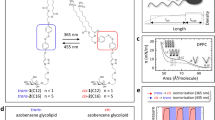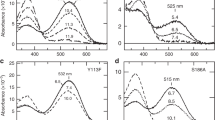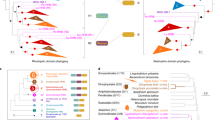Abstract
MANY reports have been made of chemical and physical properties of rhodopsin1,2. A role of rhodopsin in visual excitation has been fully discussed by Wald3,4. However, most of the work so far has been carried out using aqueous solutions of rhodopsin extracted with digitonin, resulting in a digitonin complex. Accordingly, there is a risk of observing reactions of rhodopsin different from those primarily found in vivo. Recently, electron microscopic findings on the ultra-fine structure of visual cells5,6 suggest that rhodopsin may be located between the double layers of the disk-like units of rod outer-segment which forms a monolayer. It seems useful to pursue the physico-chemical properties of rhodopsin monolayer in vitro in order to postulate models for the molecular function of rhodopsin. Weitzel et al.7 reported properties of the monolayer of vitamin A and its derivatives spread on aqueous solution. Many workers since Devaux8 have investigated the properties of protein films spread on water. We have succeeded in preparing the monolayer film of rhodopsin—vitamin A1 aldehyde combined with protein— at the air/water interface, and have measured the changes of surface pressure following illumination. An extracted rhodopsin solution was dropped on a clean aqueous surface with a micropipette as was the case with spreading a monolayer of protein. The substrate surmounted with rhodopsin consisted of a phosphate buffer solution having pH of 6.8. The surface pressure exerted on the film was measured with a modified method of Sasaki9 under dim red light of wave-length longer than 750 mµ. To plot the film pressure against the area of the spread films, a barrier placed at a distance of 40 cm. from the other fixed barrier was slid on a trough at a constant speed with certain intervals until the distance was reduced to about 25 cm. Thus the plotting of the film pressure yielded a force-area curve. Besides the force-area curve, changes of surface pressure were measured at any area. In the meantime the barrier was kept unslid so that the rhodopsin film might reveal an unstable surface pressure. A rhodopsin solution extracted with diluted ethanol reported by Hosoya et al.10 seemed to be the most suitable agent in preparing a monolayer film. The digitonin extract did not seem to be satisfactory in monolayer experiments, because of the surface activity of digitonin and higher molecular weight of digitonin complex; but it might be observed in comparison with ethanol extract. Fig. 1 shows the force-area curve of the monolayer film of rhodopsin extracted with diluted ethanol. At a low-pressure region, surface pressure increased slowly as the area was diminished.
This is a preview of subscription content, access via your institution
Access options
Subscribe to this journal
Receive 51 print issues and online access
$199.00 per year
only $3.90 per issue
Buy this article
- Purchase on Springer Link
- Instant access to full article PDF
Prices may be subject to local taxes which are calculated during checkout
Similar content being viewed by others
References
Morton, R. A., and Pitt, G. A., Progress in the Chemistry of Organic Natural Products, 14, 245 (Springer, Wien, 1957).
Dartnall, H. J. A., The Visual Pigments (Methuen, London, 1957).
Wald, G., and Brown, P. K., J. Gen. Physiol., 37, 189 (1953).
Wald, G., Handbook of Physiology, Sec. 1, 1, 671 (Amer. Physiol. Soc., Washington, 1959).
Sjöstrand, F. S., J. Cell. Comp. Physiol., 42, 15 (1953).
Lasansky, A., and Robertis, E. D., J. Biophys. Biochem. Cytol., 5, 245 (1959).
Weitzel, G., Fretzdorff, A. M., and Heller, S., Hoppe-Seyler's Z. Physiol. Chem., 290, 32 (1952).
Devaux, H., P.V. Soc. Phys. Nat. Bordeaux (Nov. 19, 1903).
Sasaki, T., Nippon-Kagakkaishi, 62, 796 (1941).
Hosoya, Y., and Kimura, E., Protein, Nucleic Acid, Enzyme, 5, 458 (1960).
Bull, H. B., Adv. Protein Chem., 3, 95 (1947).
Author information
Authors and Affiliations
Rights and permissions
About this article
Cite this article
HYONO, A., KURIYAMA, S., TSUJI, K. et al. Monolayer Film of Rhodopsin at the Air/Water Interface. Nature 193, 679–680 (1962). https://doi.org/10.1038/193679b0
Issue Date:
DOI: https://doi.org/10.1038/193679b0
Comments
By submitting a comment you agree to abide by our Terms and Community Guidelines. If you find something abusive or that does not comply with our terms or guidelines please flag it as inappropriate.



